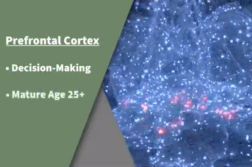MADISON, Wis. (Ivanhoe Newswire) — Imagine doctors telling you that your child does not only have a genetic disease like NF1, but a disease that has no effective way to test for therapies or even predict how the disease may progress. Now researchers at the University of Wisconsin, Madison believe they have found a way to get these kids and their families the help they need.
Like a lot of girls, nine-year-old Lauren Geier loves playing with her dolls.
Ryan Geier, Lauren’s dad, said, “She is the most motherly figure you will ever meet. She babies these things like they’re real kids.”
But unlike most kids, Lauren has a rare form of neurofibromatosis type one, or NF1, in which there is a microdeletion, or a chunk of her chromosome is missing.
“Her diagnosis is more like one in 80,000. There’s no blueprint. There’s no way to understand fully what’s going to happen,” said Ryan.
Most people will have some level of behavior or learning disabilities and are prone to getting nerve and brain tumors. But NF1 is complex and different from person to person.
“The biggest hurdle in this research area has been is that there was no real way to study the disease because there aren’t enough children with the same mutation,” said Dhanansayan Shanmuganayagam, PhD, Director of Biomedical & Genomic Research Group at the University of Wisconsin – Madison.
But now, researchers are using genetically engineered pigs to study the disease. Using the gene-editing tool CRISPR, the researchers genetically alter the embryo of a pig and then impregnate a female pig with the embryo.
“we’re trying to create a pig that sort of represents a particular child. And therefore, we can really customize the treatment or the therapy,” said Shanmuganayagam.
The first set of piglets were born in November 2016. There were eight in total and four of the piglets carried the NF1 mutation. That was a win for the Geier family.
“When we heard there would be a possibility of creating essentially a twin pig that has this microdeletion, it gave us hope,” said Lindsay Geier, Lauren’s mom.
And a little more insight into the NF1 disease.
When symptoms do present itself with NF1, people are their own guinea pig to find a treatment that works, which can be time consuming. People also have to endure side effects of the treatments that do not work. Having a pig mirror a person’s specific form of NF1 can narrow down the best treatments faster.
Contributors to this news report include: Milvionne Chery, Field Producer; Cyndy McGrath, Supervising Producer; Bruce Maniscalco, Videographer; Ken Ashe, Editor.
To receive a free weekly e-mail on Medical Breakthroughs from Ivanhoe, sign up at: http://www.ivanhoe.com/ftk
MEDICAL BREAKTHROUGHS
RESEARCH SUMMARY
TOPIC: PIGS HELP KIDS FIGHT NF1
REPORT: MB #4613
BACKGROUND: NF is known as neurofibromatosis and it is a genetic disorder that comes in three types, NF1, NF2, and schwannomatosis that affects one in every 3,000 people. NF1 is the most common type of the three. The most prominent symptom of the disease is the café au lait, or light brown spots, of the skin as well as small benign growths that are on or under the skin. Most people suffering from NF1 will also experience some learning disabilities. The benign tumors that are caused due to the disorder could also start to form in places like the brain, cranial nerves, and spinal cord. The tumors themselves are not cancerous and may not cause any harm, but they can cause health issues for patients by pressing down on nearby tissue.
(Source: https://www.ctf.org/understanding-nf/nf1)
TREATMENT: As of right now there is no cure for neurofibromatosis. Doctors focus on controlling and treating the symptoms. The disorder is so complex and so different in every single patient that there is not even one standard treatment. Some of the symptoms like café au lait do not need any treatment, but once in a while treatment is necessary. When it is necessary treatments include surgery to remove the benign tumors, chemo or radiation, physical therapy, cataract removal surgery, and treatment for any associated pain. Schwannomatosis can be very debilitating and patients can experience severe pain.
(Source: https://www.webmd.com/pain-management/neurofibromatosis#3)
NF1 STUDY: Dhanansayan Shanmuganayagam, PhD, Director of Biomedical & Genomic Research Group at the University of Wisconsin – Madison explains how their new study involving pigs is helping his team get closer to understanding NF1. “We decided to genetically engineer them to have the mutation that would be found in a child. Then we could study the disease in the pig. And then we could try to discover new drugs or therapies using the pig as the model. We’re hoping that it will allow us to find either a cure or a therapy.”
FOR MORE INFORMATION ON THIS REPORT, PLEASE CONTACT:
Dhanansayan Shanmuganayagam, PhD
If this story or any other Ivanhoe story has impacted your life or prompted you or someone you know to seek or change treatments, please let us know by contacting Marjorie Bekaert Thomas at mthomas@ivanhoe.com




